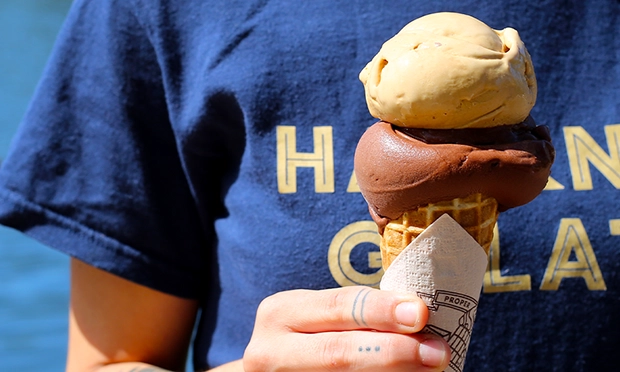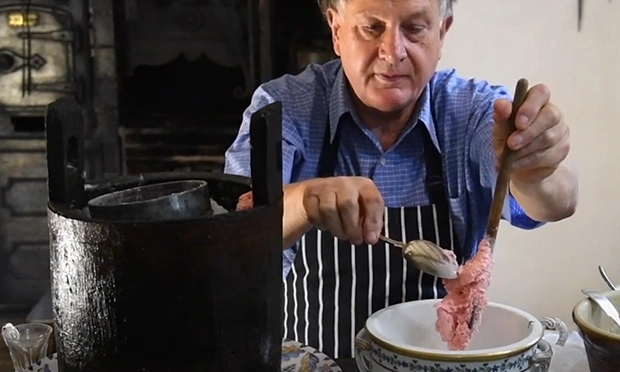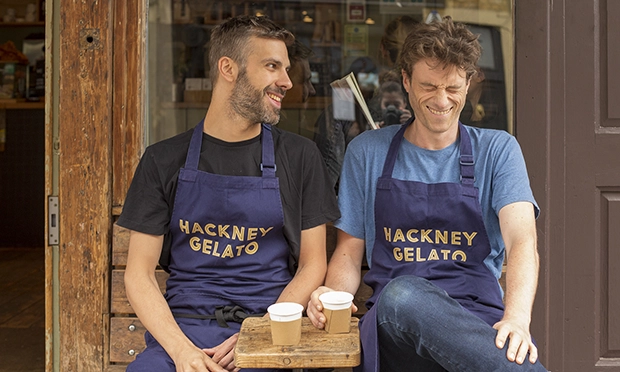Cream of the crop

Hackney Gelato’s sea salted caramel and dark chocolate sorbetto. Photograph: Hackney Gelato
It’s a long time since three furtive infants hid a huge tub of commercial ice cream in the supermarket trolley. Back home, their father Robin Weir was horrified not just at the price, but at the ingredients in the small print – none of the cream, milk, eggs, and fresh flavours we have come to expect in honest ice cream, but a lot of what must be the most expensive fresh air on the planet, whipped into a mush of dubious ingredients.
Decades later, Robin and his wife Caroline, knee-deep in ice cream memorabilia, historic equipment, books, prints and grandchildren, wrote what I think is the best book ever on the subject, Ice Creams, Sorbets & Gelati: The Definitive Guide – a manic collection of explanations and recipes, with amazing illustrations.

Ivan Day demonstrating historic ice cream-making techniques. Image: courtesy Ivan Day
Alongside this treasure trove of information we can enjoy the food historian Ivan Day’s videos and blog, Food History Jottings.
Ivan is unique in having the history of ice cream at his fingertips, along with a working collection of historic equipment to back up his serious collection of printed material and manuscripts. He makes the stuff the way it was done until quite recently. The speed and efficiency of historic methods is impressive.
Meanwhile, the name Hackney Gelato may imply a struggle by unknown local lads from small beginnings to eventual recognition. In fact, the pair behind the product, Sam and Enrico, were already accomplished young Italian chefs – and supplying equally successful chefs with sophisticated ice cream for their refined menus – when they sprang fully armed like Athene from the brow of the god Zeus, bringing a deserved reputation to a receptive public. ‘Hackney’ is now a buzzword for fresh, innovative and creative food, and our friends at Gelato have been astute in their choice of a good site and appreciative clients.

Enrico and Sam, founders of Hackney Gelato. Photograph: Hackney Gelato
Ice cream as crowd control
Antonio Latini’s recipe books included descriptions of feasts and banquets held in the picturesque countryside outside Naples. No expense was spared to create a carefree, rustic atmosphere, with happy peasants disporting themselves in the streets – not a hint of the social and political unrest seething under the surface.
Latini was wise to avoid whiffs of the political undertones, but describes menus and recipes in much detail. He only mentions in passing the lavish supplies of ice cream offered to even the humblest of the crowd. How can civic unrest happen when restless dissidents have a bowl of delicious ice cream in one hand and a spoon in the other? Keep it coming.
So the court kitchen staff must have been rushed off their feet keeping up with the supply of ice cream. They used a simple technology which has only recently disappeared. We don’t know if it was a crazed boffin in a heatwave in 17th-century Florence, or a cunning Neapolitan entrepreneur, who made the technical breakthrough that changed the shape of puddings forever. Crushed ice mixed with salt creates a much lower temperature than ice on its own, so instead of just cooling a liquid or cream, a pail of ice and salt could freeze the contents of a tub in record time, as Robin Weir and Ivan Day have shown so vividly.
